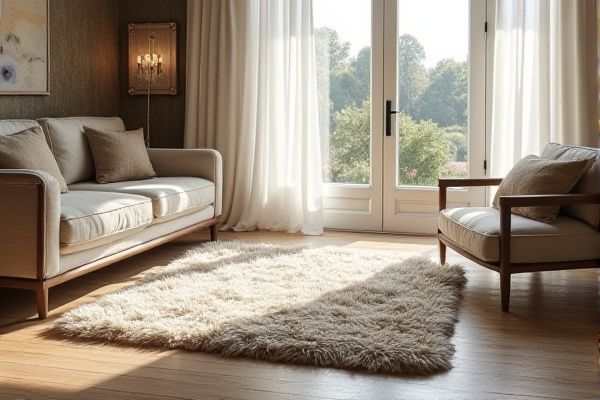
Moisture-resistant rugs are designed to repel water and prevent mold or mildew, making them ideal for damp environments, while UV-resistant rugs protect against fading and damage caused by prolonged sun exposure, perfect for outdoor or brightly lit areas. Discover which rug best suits your needs by exploring the detailed comparison in the rest of this article.
Table of Comparison
| Feature | Moisture-Resistant Rug | UV-Resistant Rug |
|---|---|---|
| Primary Benefit | Prevents mold, mildew, and water damage | Protects against fading and sun damage |
| Material Composition | Synthetic fibers like polypropylene, polyester | UV-stabilized polyester, olefin, acrylic fibers |
| Ideal Usage | High humidity areas, bathrooms, kitchens, outdoors | Outdoor spaces with direct sun exposure, patios, decks |
| Durability | Resistant to water absorption and damage | Maintains color integrity under UV exposure |
| Maintenance | Easy to clean, quick-drying | Resists color fading, requires periodic cleaning |
| Cost | Moderate | Typically higher due to UV protection technology |
Understanding Moisture-Resistant Rugs
Moisture-resistant rugs are designed with materials and construction that prevent water absorption, reducing the risk of mold, mildew, and damage in damp environments such as basements or bathrooms. These rugs typically feature synthetic fibers like polypropylene or polyester, known for quick drying and durability against spills and humidity. Understanding the specific needs of your space helps determine whether a moisture-resistant rug is essential to maintain cleanliness and longevity.
What Are UV-Resistant Rugs?
UV-resistant rugs are specifically designed to withstand prolonged exposure to sunlight without fading or deteriorating, making them ideal for outdoor or sunlit indoor spaces. These rugs are often treated with special dyes and materials that block harmful ultraviolet rays, preserving color vibrancy and fabric integrity. In contrast to moisture-resistant rugs, which repel water and prevent mold growth, UV-resistant rugs focus on maintaining aesthetic appeal and durability under strong sunlight.
Key Material Differences: Moisture vs UV Protection
Moisture-resistant rugs are typically made from synthetic fibers such as polypropylene or polyester, which repel water and prevent mold or mildew growth, ideal for damp environments. UV-resistant rugs use materials treated with UV inhibitors or fibers like solution-dyed acrylic, designed to withstand sun exposure without fading or degrading. Both types prioritize durability but target distinct environmental challenges--moisture control versus sun protection--through specialized fabric technologies.
Ideal Indoor and Outdoor Applications
Moisture-resistant rugs are ideal for indoor spaces prone to humidity and occasional spills, such as kitchens, bathrooms, and basements, while UV-resistant rugs excel in outdoor areas exposed to direct sunlight, like patios, decks, and balconies. Your choice depends on the environment's dominant challenges: moisture-resistant rugs prevent mold and mildew indoors, whereas UV-resistant rugs maintain color vibrancy and structural integrity outdoors. Selecting the right rug enhances durability and performance in your specific indoor or outdoor setting.
Durability & Longevity in Different Environments
Moisture-resistant rugs are designed to withstand damp environments by preventing mold, mildew, and water damage, making them ideal for bathrooms, basements, and outdoor patios exposed to humidity. UV-resistant rugs, on the other hand, excel in maintaining color vibrancy and structural integrity under prolonged exposure to sunlight, perfect for sunny decks, sunrooms, or outdoor areas with direct UV rays. Choosing the right rug depends on the predominant environmental factor--moisture or sun exposure--to maximize durability and extend the rug's lifespan in specific settings.
Maintenance and Cleaning Requirements
Moisture-resistant rugs require regular drying and prompt spill cleanup to prevent mold and mildew growth, making them ideal for humid environments or areas prone to moisture. UV-resistant rugs maintain color integrity and resist fading even with prolonged sun exposure, reducing the need for frequent replacement but still benefiting from occasional cleaning to remove dirt and dust. Both rug types demand specific maintenance: moisture-resistant rugs need adequate ventilation, while UV-resistant rugs benefit from routine brushing or vacuuming to preserve their protective coatings.
Color Fading: Sunlight Versus Moisture Exposure
Moisture-resistant rugs prevent damage caused by water exposure, such as mold and mildew, but may still experience color fading over time due to prolonged sunlight exposure. UV-resistant rugs specifically block or absorb ultraviolet rays, significantly reducing color fading caused by direct sunlight, maintaining vibrancy longer. Selecting a UV-resistant rug is critical for outdoor areas receiving intense sun, while moisture resistance is essential in damp environments to preserve rug integrity beyond color retention.
Cost Comparison: Initial Investment & Long-Term Value
Moisture-resistant rugs generally offer a lower initial investment compared to UV-resistant rugs due to their simpler manufacturing materials, making them a cost-effective choice for damp environments. UV-resistant rugs, while often more expensive initially, provide long-term value by maintaining color vibrancy and structural integrity when exposed to sunlight, reducing replacement frequency. Evaluating the total cost of ownership reveals that UV-resistant rugs can be more economical over time in sun-exposed areas, whereas moisture-resistant rugs excel in wet or humid settings.
Best Options for Pet and Kid-Friendly Spaces
Moisture-resistant rugs are ideal for pet and kid-friendly spaces as they prevent mold and mildew buildup from spills and accidents, ensuring easy cleaning and long-lasting durability. UV-resistant rugs maintain their color and structural integrity when exposed to sunlight, making them suitable for sunlit playrooms or patios where children and pets often spend time. Choosing a rug that combines both moisture and UV resistance offers optimal protection and performance in environments prone to stains, wear, and sun exposure.
How to Choose: Moisture-Resistant or UV-Resistant Rug?
Choosing between a moisture-resistant rug and a UV-resistant rug depends on the primary environmental challenges your space faces. Moisture-resistant rugs are designed to prevent mold and mildew buildup, making them ideal for humid areas like bathrooms or basements. UV-resistant rugs, on the other hand, protect against fading and sun damage, which is crucial for outdoor patios or rooms with intense natural light exposure.
 homyna.com
homyna.com